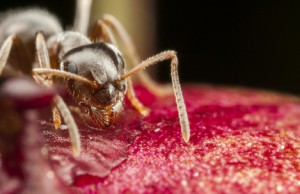
Ever noticed a single-file line of ants who all know exactly where they are going? Their sense of direction comes from a trail of pheromones left behind. However, in recent years scientists have discovered that ants also communicate through sound.
How ants “talk”
The rear part of an ant, the abdomen, has a small spike on its underside. Ants can rub this spike with a leg to produce a small rattling noise. It’s so faint that entomologists were unaware of it until recently, but it’s loud enough to sound an alarm to nearby ants.
An ant’s call for help
When ants feel threatened by a predator — larger insects, animals, or even people — they sound an alarm to alert their friends. When other ants hear the noise, they can guage the location of the cry for help.
Amazingly, other ants can figure out the maturity of the ant crying for help. That determines whether they should bother to save the nestmate.
Age before beauty?
In a moment of crisis, ants scramble to protect the older members of their nest. They certainly have no concept of saving the women and children first! Ant larvae cannot make noise or produce pheromones, so they get left behind. Adults and advanced pupae can successfully call for help.
Humans, of course, have their own way to call for help — call Allison Pest Control to stop an ant infestation!